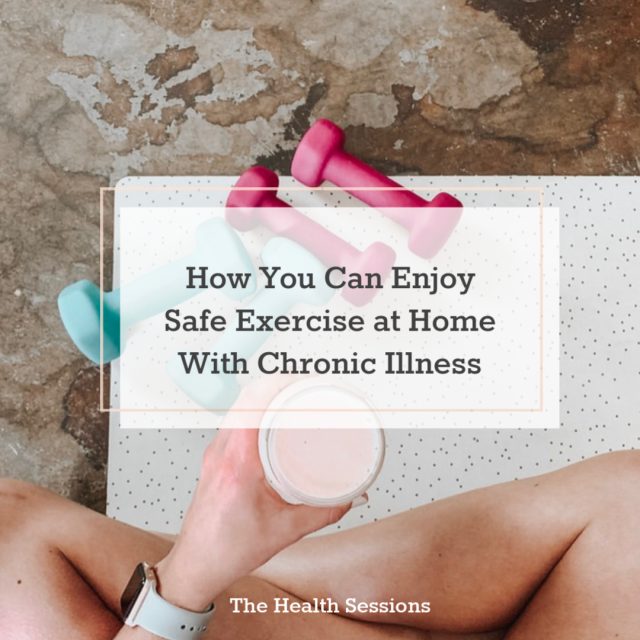Living with Lyme and POTS: Sophia Galpin on Limitations and Listening to Your Body

This article is written by Jacklyn Donalds.
Exercise can and should be considered an important part of your strategy in combatting chronic illness – considering its important effect on aspects such as depression, weight maintenance, and vitality. While some of the most common chronic illnesses in America – including heart disease, cancer, and diabetes, won’t necessarily keep you at home, if you are in recovery or your illness has affected aspects like strength, balance, and flexibility, building your fitness at home can be beneficial in many ways. Research by the National Sleep Foundation found that people who exercise report better sleep than those who don’t. Quality is as important as quantity, and there are specific criteria that need to be met for sleep to be truly restorative and reinvigorating.
As noted by the Mayo Clinic, exercise wields important health benefits for people facing a number of chronic illnesses, including heart disease, diabetes, asthma, and back or joint pain. Osteoarthritis – which affects over 21 million Americans – can also present reduced symptoms when regular exercise is undertaken. If you have a chronic illness, speak to your specialist about appropriate levels of physical activity, and suggested workouts.
With some conditions – including mitral valve regurgitation – your doctor may recommend that you limit your physical activity. This will be the case for any condition that causes you to quickly feel breathless and tired. However, limited exercise does not mean no exercise. Academics at the University of Michigan note that even if you have mild to moderate mitral valve disease and reduced heart function, “you might be able to exercise at low or moderate aerobic levels such as walking or swimming.”

Every home has larger and smaller areas. If you have a beautiful yard or garden, this might make the ideal place to walk or practice a calming exercise like yoga. If you have a large unused room, you might decide to utilize it to create a home gym. If your doctor has recommended walking or training on a home elliptical machine, choose a machine that is small enough to fit in your home. You should be able to get on and off the machine safely and use other equipment comfortably.
At your home gym, you might also decide to include a few free weights. You will need little more than a few dumbbells and a bar for chest exercises and squats. Ensure that a physiotherapist or qualified personal trainer creates a strength routine that is in line with your doctor’s instructions. Building strength is key, and weights exercises will help ensure your muscle-to-fat ratio is where it should be, which is important if you are battling obesity and Type 2 diabetes. If you have osteoarthritis, meanwhile, take note: a 2010 study found that strength training is vital, since it significantly improves strength and function, and decreases pain.
If you have always had a preferred sport or routine, see how you can adapt it to your needs at home. Yoga is one activity that is
particularly flexible to different fitness levels. It can also be practiced at home with nothing more than a mat and a beautiful view required. Yoga is currently used to reduce the stress associated with many chronic illnesses, including cancer. In one study on women receiving radiotherapy for breast cancer, this millenary activity was found to significantly lower levels of stress hormone, cortisol.
In another 2017 study, it was found that chair yoga (which involves the use of a chair to provide extra stability) is an effective alternative treatment for osteoarthritis. Chair yoga essentially reduces pain and improves quality of life, while helping people avoid medication in some cases. If you have osteoarthritis, consider trying out this activity, obtaining permission from your doctor before making any changes to medication.

Your home gym should ideally look out onto a green space, or contain lush indoor plants and nature imagery. A study published in the journal Extreme Physiology & Medicine found that exercising in a green environment causes greater feelings of revitalization and positive engagement. ‘Green exercise’ also boosts self-esteem and mood, and lowers anger and depression. The mental benefits of nature are particularly important for people with chronic illness, since the latter is strongly linked to depression.
When choosing your exercise form and building the right ambience at home, make décor, music, and surrounds an important part of the experience of building a happier mood. Studies have shown that simply viewing nature scenes increased heart rate variability (HRV) – an important indicator of heart health. If you don’t have a window looking out, why not build one? Sliding glass doors that open out into the yard are ideal for a naturally lit gym that is mainly used in the daytime.
For many people with chronic illness, working out at home is a lifesaver when it comes to keeping their self-confidence, energy, and motivation up. Because the effects of chronic illness vary from condition to condition, obtaining approval from your doctor is vital when it comes to starting a home exercise routine.
Building a home gym is easy if you have enough room. You don’t need to undergo significant expense, though a few renovations (including knocking down walls to let in more natural light) can help you feel motivated to exercise every day. If you have a beautiful garden, something as easy as yoga will have a big effect on issues like pain, motivation, and vitality. If you are strong enough to work out at the gym, keep your home fitness oasis for weekends or moments when you simply can’t get away.
If you enjoyed reading this article, you might also like: